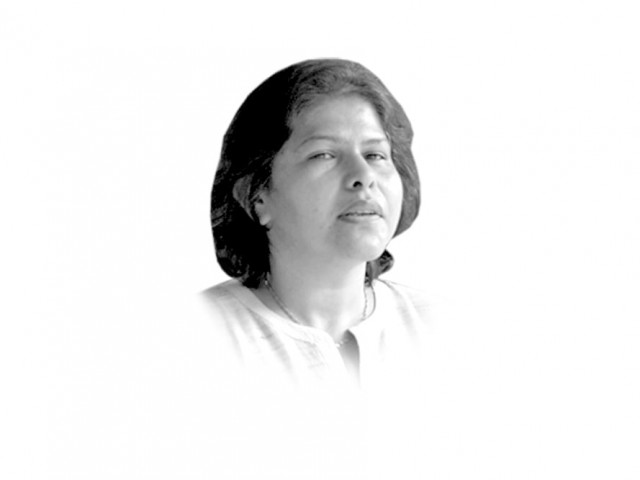Land of Jinns
In the 115 tehsils studied in south Punjab, the authors found 64 shrines with direct political connections

The writer is an independent social scientist and author of Military Inc. She tweets @iamthedrifter
Imagine the number of tourists who would come to see these places, including the famous Derawar Fort, whose picture is found on most posters on Pakistan, but in reality is falling apart rapidly due to the folly and shortsightedness of the family of the Nawab of Bahawalpur. A former princely state, Bahawalpur is strewn with old forts and palaces that must be preserved as part of history. But why just blame the Nawab’s family? The provincial government can take over these forts and palaces under the Land Acquisition Act of 1894 after they are declared national monuments under the Antiquities Law 1975.
Perhaps, there are other reasons for the lack of action which have more to do with the deliberate neglect of the area. I am referring to the overall attitude of governments towards south Punjab, which is only considered as a place from where votes and political support are gathered but it is never developed on a par with central or north Punjab. So, the monuments or people of the sub-region are less important than those in Lahore, where the provincial government has invested in preserving historical sites. This results in the general dissatisfaction among people in south Punjab with being part of a larger province where powers are concentrated in its capital, Lahore.
The counter-argument is that the ruling elite of south Punjab are also party to the state’s excesses or negligence. It was not until the last PPP government that the only large city of the sub-region, Multan, got attention and there was some infrastructure development. The federal government now plans to bring in some additional infrastructure. This feels more like a knee-jerk reaction to attending the needs of a sub-region that was neglected for long and was run by the state via proxies, as in the case of interior Sindh.
You may consider this a personal bias since I am from south Punjab. However, I recently saw a valuable and thought-provoking study done by a team of Oxford-based economists, Adeel Malik and Rinchan Ali Mirza, on certain areas of south Punjab, namely Multan and Bahawalpur. Although the study, based on empirical data, focuses on the relationship between shrines and the low levels of literacy, the paper draws out the traditional patronage system used by the colonial, and then the post-colonial state, to run the place. The study selected some shrines in Multan and Bahawalpur to investigate causal relationships in using the dominance of land, religion and politics by pir-zamindar families in depriving the general public of a service like education.
According to the study, there is no difference between north, central and southwest Punjab as far as density of shrines is concerned. In fact, the largest cluster was in Lahore. However, there are a larger number of shrines in south and southwest Punjab, which have strong links to families that are traditionally in politics too. In the 115 tehsils studied in south Punjab, the authors found 64 shrines with direct political connections. This is not a reflection on Sufi ideology but on the institutionalised power of shrines that was used by all — the Mughals, the British and later, the Pakistani state — to gain legitimacy vis-a-vis society by using religious icons and families. The power structure depended on pir-zamindars to negotiate between the state and society, which meant that land and power distribution would remain skewed. The British recognised this power by including pirs as a category of agricultural class that was distributed land as per the Alienation of Land Act of 1900. The idea was to capitalise upon local power structures. South Punjab is very similar to Sindh in terms of social ethos and treatment of people by the state. Nevertheless, it will be interesting to see a comparative study with shrines in central and north Punjab, some of which might not have direct links with politics, yet people associated with them play a significant role as political powerbrokers. The shrines around Islamabad/Rawalpindi are a case in point.
The main conclusion is that the negative impact of this phenomenon on literacy was most visible in areas where shrines were within 10km or less, of a river. But this may not just be due to the shrines, but the popular religio-political-power combine in which the state chooses to ignore distant areas that become as invisible as jinns. Areas near rivers in south Punjab are poor and neglected to such a degree that they have turned into hotbeds of underdevelopment, crime and now radicalism. The state is as disinterested in developing these areas as the local pir-zamindar. During one of my own studies on south Punjab, I found schools that were non-functional and were being used for cattle or grain storage by the local zamindar, just like in Sindh. I also found schools where the faculty was influenced both by the zamindar and militant groups.
At the end of the day, central and north Punjab are different due to the varied attention given by the state since colonial times. The government must understand that bringing its staple Metro bus to Multan or a solar plant to Bahawalpur is not the solution. South Punjab needs attention, in the absence of which the only option for many people, like the woman I mentioned in the beginning, is to believe in myths.
Published in The Express Tribune, July 2nd, 2015.
Like Opinion & Editorial on Facebook, follow @ETOpEd on Twitter to receive all updates on all our daily pieces.














COMMENTS
Comments are moderated and generally will be posted if they are on-topic and not abusive.
For more information, please see our Comments FAQ